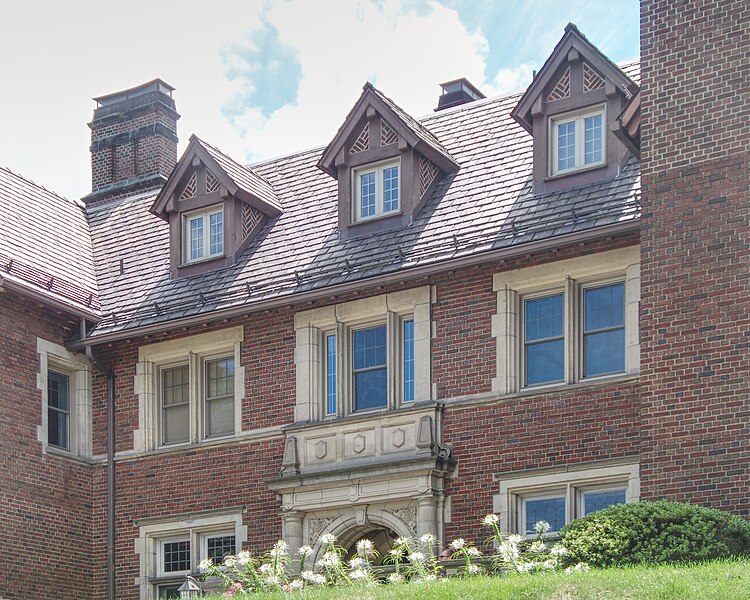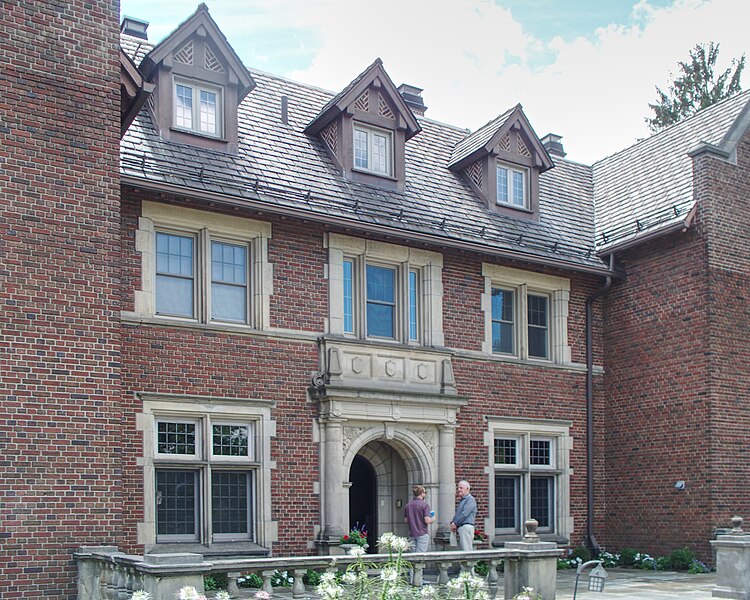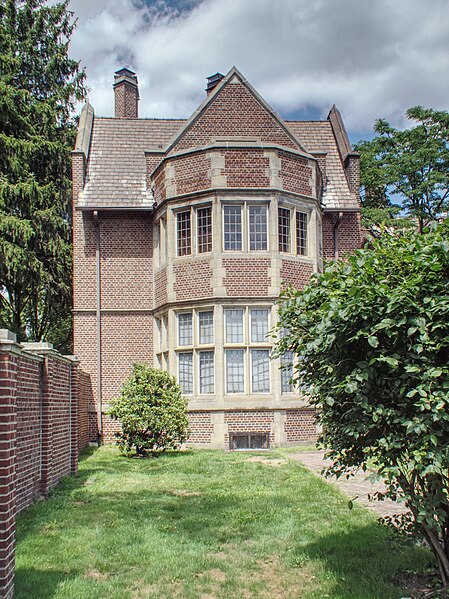
-
Magnolias on Kamin Street, Squirrel Hill
-
Peoples-Pittsburgh Trust Co., Squirrel Hill

You could count on architect Press C. Dowler for the bankiest-looking banks. The correct Ionic front of this one looks almost exactly the way he drew it, as we can see from the architect’s rendering that was published in the Press on February 8, 1931.

It seems to old Pa Pitt that the mark of a Dowler bank is correct classical detail combined with a lack of fussiness. There is never too much detail. But he takes the details seriously. In other buildings he was already adopting Art Deco and modernist styles, but a bank needed to look traditional and timeless—especially in the Depression. For other Dowler bank designs, see the Coraopolis Savings and Trust Company and the Braddock National Bank.
Comments -
Apartment and Commercial Block on Murray Avenue, Squirrel Hill

A commercial building and apartment block in the eclectic style popular in the 1920s: it carries a whiff of Spanish Mission, but also a bit of Renaissance. Liberal use of terra cotta enlivens the façade.


Comments -
House by Alexander Sharove in Squirrel Hill

Alexander Sharove is best remembered today for the synagogues he designed, but like most architects he took on a variety of jobs, including this house built in 1937 for Stanley Hohenstein in the less expensive end of Murdoch Farms. Here Sharove juggles an eclectic assortment of styles from Jacobean to Georgian to Moderne.


The arch with rays was a popular motif in the 1930s. Sharove’s version of it uses thin strips of terra cotta for the rays.


Sony Alpha 3000, Canon PowerShot SX150 IS.
Comments -
The Blinker House in Murdoch Farms

This house, built in 1925, was designed by Charles Tattersall Ingham, according to an article in the Trib from back in September. Ingham was half of the firm of Ingham & Boyd, a big deal around here—they designed many of our biggest schools, including all the schools in Mount Lebanon for decades. Both Ingham and Boyd had a mania for symmetry. They also had a taste for the classical in architecture, but they disliked columns. It takes all kinds.

But why is it called the “Blinker House”? The Trib article explains that it sits at a very complicated five-way intersection, where years ago there used to be a flashing red light. The blinker is long gone, but Pittsburghers have long memories, and everyone in the neighborhood knows it as the Blinker House.

As of this writing, the house is for sale, and the asking price is a little under 2½ million dollars—down from 2.6 million when the Trib article was written.

Sony Alpha 3000.
Comments -
Murdoch Farms in the Snow

Murdoch Farms, a dairy farm until the early twentieth century, is the most expensive section of Squirrel Hill. In the 1920s it filled up with mansions designed by our leading architects, and most of them are still in close to original shape, at least on the outside. Father Pitt took a stroll on a dim and snowy afternoon to get a few pictures.











Sony Alpha 3000. We’ll see more of Murdoch Farms from this same expedition, including some individual houses whose architects old Pa Pitt can identify.
Comments -
Squirrel Hill’s Manor Has the Atmosphere of a Country Club

The Manor, which opened in 1922, was designed by Harry S. Bair, who did a number of theaters around here (including the Regent, now the Kelly-Strayhorn in East Liberty). As the caption says, it was “a distinct departure from the conventional,” and the Tudor half-timbering of the exterior advertised the sumptuous club-like atmosphere of the interior. Today the exterior has been simplified, and the building expanded, but it still feels like an outpost of Merrie England on Murray Avenue.


This gable on the Darlington Road side of the building still preserves all its intricate diagonal brickwork and half-timbering.

Canon PowerShot SX150 IS. These little chimneys should have their own separate landmark status.
Almost nothing remains of the original interior, though the Manor is still a movie house, now divided into four small theaters. Originally, the lobby was a feast of luxurious furniture and decoration.

And that was just the entrance lobby. If you were meeting someone or just waiting for something, you could retire to the parlor:

There was also a men’s club room with the atmosphere of an old English manor:

After all that, movies seem almost superfluous, but the auditorium was just as luxurious as the rest of the building:

Old Pa Pitt particularly likes the arrangement of tropical plants in the orchestra pit.
Today, although the Manor is still a very pleasant place to take in a movie, almost nothing is left of that sumptuous interior except a bit of ceiling and this fine chandelier:

The 1922 pictures all came from a two-page feature in Moving Picture World for August 5, 1922, and we reprint the text of the article here (making a few silent typographic corrections).
(more…) -
Rafferty Rows, Squirrel Hill

These two long rows of houses where Beeler Street meets Wilkins Avenue make a striking impression now, but they must have been more striking when they were built in the early 1900s. For several years they sat out in the farmlands of Squirrel Hill, forming a strange urban island (along with two rows of three houses across Beeler Street) in the midst of the otherwise rural East End. We caught them on a dim and rainy evening.

1910 fire-insurance map. 
Note how the rhythm of the houses is made more interestingly varied by alternating the peaked and rounded fronts but running the oriels in a series of three.

Fujifilm FinePix HS10. -
A Rainy Evening in Murdoch Farms, Squirrel Hill

Architect: Lamont Button. It was rainy and dim, so don’t expect too much of these pictures. But old Pa Pitt happened to be in Squirrel Hill just before dark with half an hour to waste, so he took a walk in the rain in Murdoch Farms, one of the richest parts of Squirrel Hill, and did what he could with the camera.



Architect: Edward Crump. 







Fujifilm FinePix HS10. -
Warwick House, Squirrel Hill

Warwick House was built in 1910 for Howard Heinz, son of the ketchup king H. J. Heinz. The architects were Vrydaugh & Wolfe, who designed several other millionaires’ mansions around here, as well as a number of fine churches. The house now belongs to the Catholic Diocese of Pittsburgh, and it is rented to Opus Dei for a dollar a year, under the condition that the tenants undertake the maintenance, which is enormous.
Once a year the residents throw a big open house, which gave us a chance to get a few pictures. We would have got more, but we were having too much fun.




A French door in the back leading out into the garden.

The rear of the ballroom, an addition built in about 1929. It is now a chapel.

An arbor with some splendid ironwork runs along the back of the garden.


From an earlier visit, we also have several pictures of the interior of Warwick House.
Cameras: Kodak EasyShare Z1285; Fujifilm FinePix HS10. Most of the pictures are HDR stacks of three photographs at different exposures.
